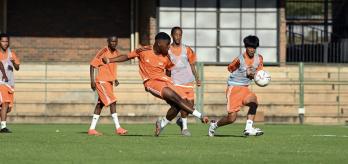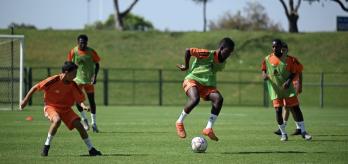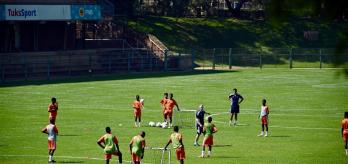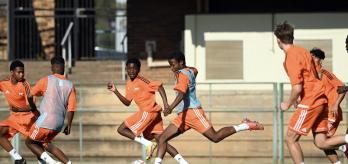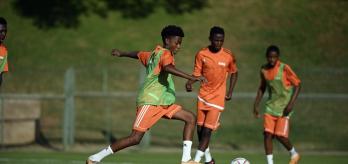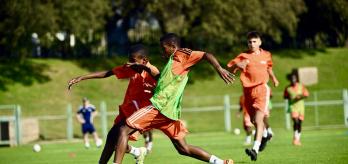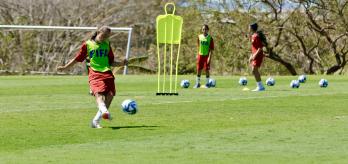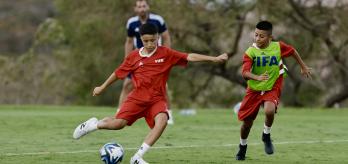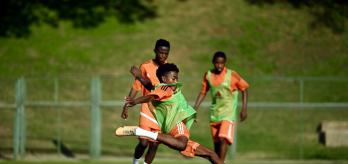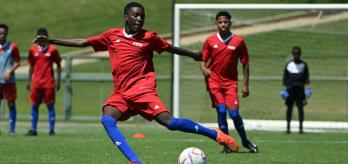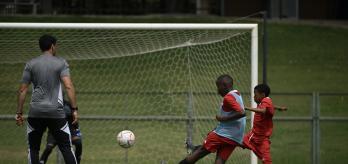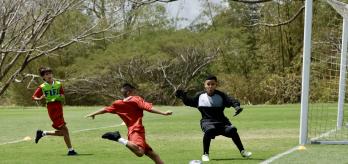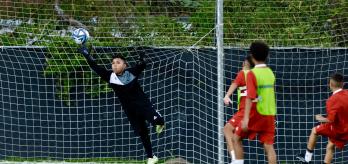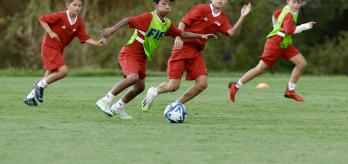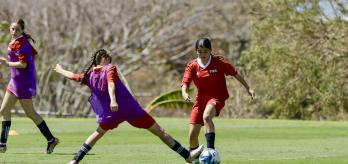Methodology
The intention: What is practised?
This exercise involves a sequence of finishing scenarios that help players to become more effective at creating shooting opportunities in 1v1, 2v2 and 3v3 situations. The drill focuses on player-level actions, such as creating angles and the space between themselves and the defender to shoot. Players are asked to set themselves up for a shot by ensuring that their first touch takes them in the direction in which they intend to shoot and by lining up their bodies with the area of the goal towards which they plan to shoot. Off-the-ball movement is crucial in the 2v2 and 3v3 scenarios in this exercise, and out-of-possession players are asked to drag defenders away from certain areas to enable the ball carrier to drive into space or cut inside before shooting.
The scale: For whom is this relevant?
This finishing drill revolves around the player scale and focuses on an attacker’s ability to beat a defender before going on to score. The exercise is particularly relevant to attacking players, such as wingers, centre-forwards and second strikers, and requires players to adopt a direct and bold approach and exposes the attackers to various 1v1 finishing scenarios. The drill encourages attackers to be bold and aggressive in their approach by driving at their defender and shooting, even when they do not have full sight of the goal. The exercise is non-position-specific, with all players asked to perform attacking and defending duties.
The practice type: How is the practice designed?
The exercise is performed in and around the penalty area and features a full-size goal that is defended by a goalkeeper. The reduced size of the playing area means that attacking players are in close proximity to the goal at all times, which encourages them to get a shot away quickly. The fact that players are limited to three touches in the first 1v1 scenario forces them to shoot quickly and sets the tone of the exercise. The aggressive approach that the defenders are asked to adopt is designed to replicate a real-game scenario and to make it more challenging for the attackers to find the space to shoot. Lastly, having three sequences means that the attackers have to adapt to various scenarios, some of which involve them having the support of team-mates and others see them come up against more defenders.
Session plan
Organisation
-
Position a full-size goal at the end of the exercise area furthest from the halfway line. Place a goalkeeper in the full-size goal.
-
Mark out a 30m x 20m playing area that runs towards the halfway line.
-
Place 2 mini-goals a short distance apart and facing the full-size goal along the line that marks the end of the playing area closest to the halfway line.
-
Place a cone several metres behind and at the midpoint of the line that marks the end of the playing area closest to the halfway line, i.e. the cone sits between the 2 mini-goals. This is the recovering defenders’ station.
-
Split the group into 2 teams of 7.
-
Position three blue players on each side of the full-sized goal, and the remaining blue player at the recovering defenders’ station.
-
Place 2 orange players at each corner cone of the 30m x 20m playing area closest to the halfway line and position 2 other orange players at the attackers’ station that between the mini-goals.
-
Place the remaining orange player inside the penalty arc.
Explanation
The exercise comprises 3 sequences: 1v1 (2 circuits), a 2v2 and a 3v3.
First sequence
-
The coach plays a pass into the orange player positioned inside the penalty arc.
-
The first defender enters the exercise area to set up a 1v1 scenario, sprinting towards the orange player to close them down.
-
The orange player has 3 touches to shoot on goal.
-
Once the orange player has taken a shot, the first circuit is over, and the first orange player positioned at the corner cone of the playing area plays a pass into them. The orange player is asked to take on the defender that they just faced in another 1v1 scenario. In this scenario, there is no limit on the number of touches that the orange player has to finish on goal.
Second sequence
-
The defender on the opposite side of the full-size goal to the coach plays a straight pass to the first orange player at the corner of the playing area.
-
Both the blue defender who passed the ball and the orange player who received it join their team-mates who performed the first sequence inside the playing area to set up a 2v2 scenario, with the receiving orange player dribbling the ball into the playing area.
Third sequence
-
The first orange player located between the mini-goals plays a pass to a team-mate positioned at the corner cone of the playing area.
-
The receiving orange player advances a few metres from their station to receive their team-mate’s pass inside the playing area.
-
As the orange player receives the ball, the first blue player positioned at the recovering defenders’ station joins the players who performed the second sequence inside the playing area to set up a 3v3 scenario.
Key coaching points
Roles of the coaches
-
First coach: explains the sequences and encourages the attackers to shoot as quickly as possible.
-
Second coach: starts the second circuit of the first sequence by passing the ball into the attacker positioned inside the penalty arc.
-
Third coach: observes the exercise from their position behind the mini-goals and encourages the attackers.






























